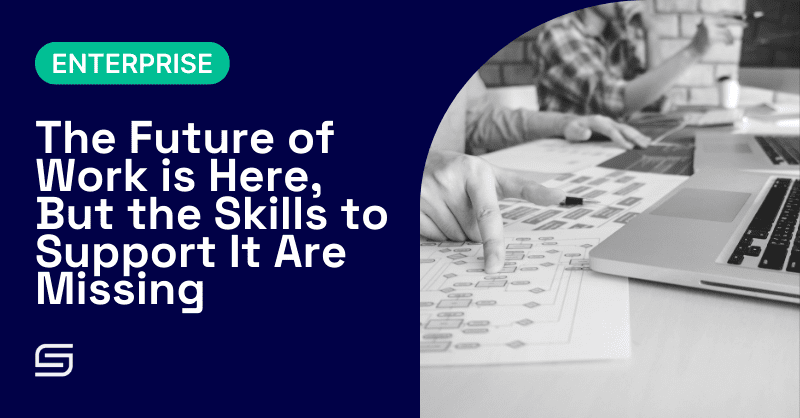The Future of Work is Here, But the Skills to Support It Are Missing

The future of work isn’t just on the horizon. It’s here. AI, automation, and cloud adoption are redefining industries, accelerating the pace of digital transformation. Yet companies racing to adopt these technologies are finding themselves stuck in the same loop. They can’t find the talent they need to keep up.
Traditional hiring models simply weren’t designed for this reality. The result? A widening gap between demand and supply that’s leaving businesses scrambling for solutions.
The Workforce is Changing, But Hiring Isn’t
Technology is advancing faster than ever. AI adoption is expected to skyrocket in the coming years, with companies leveraging machine learning, automation, and advanced data analytics to gain a competitive edge. Similarly, cloud computing is becoming the backbone of modern infrastructure, while cybersecurity demands are surging.
But here’s the issue: businesses are still using outdated hiring strategies that were built for a slower, more predictable job market. Posting job descriptions filled with rigid degree requirements and hoping the right candidate appears isn’t cutting it anymore. The talent gap continues to grow, and companies are feeling the pressure.
Why Skills Shortages Persist Despite a Growing Talent Pool
The talent pool isn’t shrinking — It’s evolving. However, skills shortages persist because traditional hiring models focus too heavily on credentials rather than capabilities. Companies are looking for unicorn candidates — people who check every technical box on paper– instead of recognizing potential in candidates who have an aptitude towards soft skills and can be trained.
- Mismatch Between Job Requirements and Available Talent: The disconnect between what employers need and what candidates offer continues to widen. Companies struggle to find talent with the right mix of technical skills and soft skills, even as the workforce grows.
- Degree-Based Hiring Limits Potential: While degrees still hold value, they no longer guarantee technical proficiency. A four-year degree in computer science doesn’t always translate to the hands-on skills companies need today. Notably, 55% of companies have removed degree requirements, particularly for entry-level and mid-level roles, according to a 2023 survey. This shift underscores the growing recognition that skills-based hiring is a more effective approach in today’s dynamic job market.
- Companies Focus on Hiring Not Building: Businesses spend heavily on recruitment without building internal pipelines for developing talent. This reactive approach creates a revolving door of candidates. It drains budgets and fails to solve long-term needs.
The Cost of Inaction: What Happens if Companies Don’t Adapt
Ignoring the talent gap isn’t an option. Companies that fail to rethink their hiring strategies risk significant setbacks:
- Delayed Digital Transformation: Without skilled talent, projects slow down, innovation stalls, and competitors gain ground.
- Higher Turnover and Retention Costs: Frustrated employees, forced to juggle responsibilities they weren’t trained for, are more likely to leave.
- Competitive Disadvantage: Businesses stuck in outdated hiring cycles will struggle to scale, secure top clients, and maintain customer trust.
The costs are significant. According to Forbes, unfilled jobs lead to lost revenue, overwhelmed employees, and stalled innovation. Companies that fail to act risk falling behind, while those that prioritize talent development will thrive.
How Skills-Based Hiring and Hire-Train-Deploy Models Solve the Problem
Investing in talent development is the way forward. Models like Hire-Train-Deploy are designed to bridge the gap. This approach identifies high-aptitude talent, trains them in specialized technical skills, and deploys them into roles that align with business needs.
- Identifying Potential: Rather than focusing exclusively on degrees or resumes, Smoothstack’s Hire-Train-Deploy approach identifies individuals with strong analytical thinking, problem-solving skills, and adaptability. These traits signal high potential, ensuring companies aren’t overlooking valuable talent that might lack traditional credentials.
- Tailored Training: Once identified, these individuals receive immersive training aligned with real-world technical needs. Whether it’s cloud architecture, cybersecurity, or data analytics, training is targeted to close gaps in critical skill sets.
- Role of Hire-Train-Deploy in Closing the Gap: Hire-Train-Deploy doesn’t just fill seats. It creates job-ready talent. By building skills in alignment with employer needs, companies gain employees who can immediately contribute. Studies suggest that skills-based hiring significantly improves retention rates and employee performance.
The tech landscape reinforces this shift. The Wall Street Journal highlights how the race for AI talent is reshaping the tech job market, pushing companies to rethink hiring strategies and invest in upskilling to secure top talent.
John Akkara, CEO of Smoothstack, echoes this sentiment in The Future is Faster Than You Think, emphasizing the urgent need for businesses to embrace workforce development models that keep pace with evolving technologies. His insights reinforce that investing in skills development is the key to staying ahead.
Implementing these strategies can lead to significant benefits. For example, skills-based hiring has been shown to reduce time-to-hire by 50% and recruitment costs by 87%.
Final Thought: The Future Belongs to Companies That Build Talent
The companies that win tomorrow will be the ones that invest in building their workforce today. By shifting away from reactive hiring models and embracing workforce development strategies like Smoothstack’s Hire-Train-Deploy, businesses can secure the skills they need to thrive.
It’s no longer enough to search for talent. To stay competitive, companies need to build it.
Let’s Build Your Team
Connect with the Smoothstack team to learn how to close your digital skills gap with a custom-trained team.